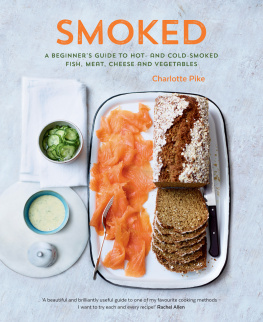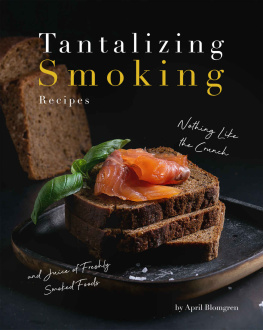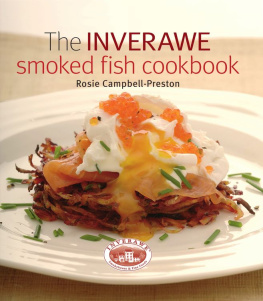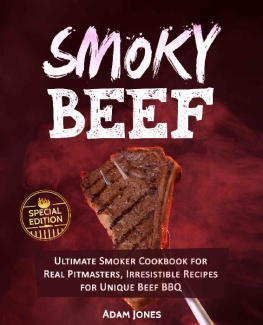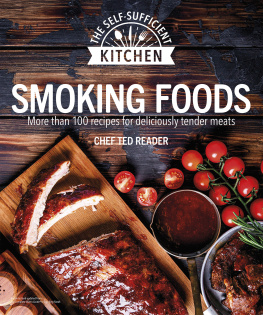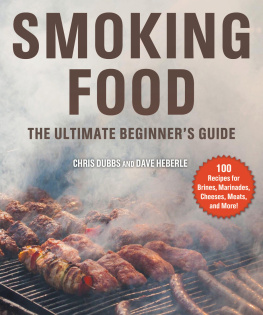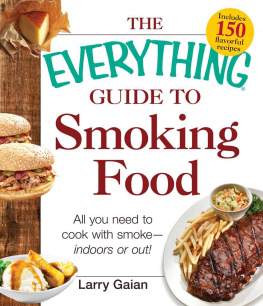smokin
Recipes for Smoking Ribs,
Salmon, Chicken, Mozzarella,
and More
with Your
Stovetop Smoker
christopher styler

To the two Joes in my life
Contents
S moked foods are a lot liked grilled foods. They have a unique depth of flavor that cannot be duplicated using other cooking methods, and, like grilling, there is a simplicity to stovetop smoking that makes it a very approachable way to cook. Even inexperienced cooks can dive right in to smoking their favorite foods on top of the stove.
But preparing smoked foods with a stovetop smoker has advantages over grilling. It requires less of your time: you dont have to hover over the smoker and continually turn or baste foods. Also, smoking is not dependent on the season. No matter what the weather conditions or time of year, your smoker can be a source of juicy, moist foods that are rich in flavor and almost effortless to prepare. You will enjoy using your smoker as much in summer, when the corn is sweetest and the tomatoes and eggplant are ripest as much as you will on a gray winters day, when a bubbling pot of Split Pea and Smoked Turkey Soup (page 70) fills the bill.
The stovetop smokers year-round appeal coupled with the ease of its operation are two of the reasons these smokers are finding their way into more and more home kitchens. Not to mention that the food tastes great and can be prepared with virtually no added fat. The recipes that follow will introduce you to the stovetop smoker or, if youre already familiar with home smoking, theyll give you fresh ideas for using it.
Hot smoking foods on your stovetop is as simple as putting together your favorite pasta dish. In this collection of recipes you will find all the information you need for simple to sophisticated dishes. The master recipes at the beginning of the chapters walk you through the process of smoking all kinds of basic ingredients from chicken breasts and beef brisket to shrimp and lamb chops. They also outline smoking times, suggest types of wood to use, and offer seasoning tips and serving suggestions. Some master recipes highlight foods that are enhanced after smoking by a brief spell in a skillet, under a broiler or over a bed of glowing coals. I refer to this process of finishing foods with a second method of cooking as Combo-Cooking. Most often, this is optional, but with foods like baby back ribs or skirt steak, it is highly recommended. And with large foods that need a relatively long time to cook, like a whole turkey or brisket, it is mandatory.
Its easy to become a creature of habit. Even after twenty-something years in restaurant and test kitchens, I found myself returning to a few tried-and-true dishes for busy midweek dinners. With a stovetop smoker, my everyday repertoire has expanded considerably. The more I use my smoker, the more stovetop smoking becomes a part of my daily dinner repertoire. I wrote this book to share my newfound enthusiasm for smoked foods with you. I hope you enjoy it.
What is a stovetop smoker?
An ingenious device that, as its name implies, sits atop your gas or electric stove and captures heat and smoke from smoldering wood chips. The heat and smoke are used to flavor and cook whatever fish, meat, poultry, or vegetables youve chosen. (Ill get more into the anatomy and operation of the smoker in a minute.)
VERY IMPORTANT!
Before you use a stovetop smoker on a smooth top electric stove, refer to your manufacturers instruction manual and guide. Many manufacturers advise against placing cook-ware larger than the burner element over the burner.
Stovetop smokers are manufactured by Camerons (CM International, Inc.) of Colorado Springs, Colorado (camerons smoker.com). They are available in many cookware specialty shops and even some upscale grocery stores, and come with a get-started guide and a small supply of wood chips. A search of the Internet will reveal scores of online sources, with slight variations in price. But, as always with online shopping, be aware of the cost of shipping.
Stovetop smokers are made of stain-less steel that is sturdy enough to stand up to repeated direct contact with heatboth from stove burners and ovens. I used one of my smokers more than a hundred times in four months while testing the recipes in this book. It is no worse for the wear, except for some blackening on the bottom, which is perfectly normal.
A similarly sturdy lid slides onto the body of the smoker. The tight fit between bottom and lid is what holds in heat and smoke during cooking. If youre wondering how to smoke larger items, such as a whole turkey (see Whole Turkey, page 101), wonder no more: When smoking items dont fit under the lid, replace the lid with an aluminum foil tent. Larger items like these are finished in the oven, in which case the foil is simply removed and the smoker doubles as roasting pan.
Camerons manufacturers the smoker in two sizes: the larger measures 15 11 4 inches deep, sells for around fifty dollars, and holds six boneless chicken breasts comfortably. (You should never crowd too much food into a smoker.) The smaller (around forty dollars) is 11 7 3 inches deep and holds about three chicken breasts comfortably. I advise purchasing the larger size, even if youre cooking most often for one or two. It is always a good idea to prepare double the amount of what you would normally cook for a meal and use the leftovers in a salad, as a snack, or in a pasta sauce. One of the advantages of cooking foods in a stovetop smoker is that they remain moist and will taste just as good in a day or two as they did right out of the smoker.
How a Stovetop Smoker Works
The stovetop smoker works on a very simple principle. Wood chips are scattered over the bottom of the smoker to produce the smoke that flavors the food inside the smoker. Your stoves burner supplies the heat needed to turn the chips into smoke and heats the inside of the smokersort of like a mini-ovento cook the food. A drip tray, which catches liquid that would otherwise moisten the chips and stop them from smoking, covers the bottom of the smoker. The food is arranged on a wire rack, which sits atop the drip pan. A sturdy sliding lid keeps smoke and heat inside the smoker. With the exception of how to replace the lid with aluminum foil for smoking large items (more on that later) and when to adjust the heat during smoking in a few of these recipes, thats all you need to know. Here is the process laid out in all its simplicity:
Read through the recipe carefully before you start. Some recipes require seasoning or marinating food in advance; other recipes suggest you brine food or take them to room temperature before smoking.
Make sure the smoker parts are clean and dry before you start.
Sprinkle the amount and type of wood chip you have chosen over the center of the bottom of the smoker, covering an area roughly the size of your burner.
Put the drip pan in place. Always line the drip pan with a single layer of aluminum foil. This cuts cleanup time in half.
Arrange whatever item(s) you are smoking on the rack. Newer smoker models have nonstick racks; older racks should be sprayed with vegetable cooking spray to prevent sticking and make for easier clean up. Be sure to leave space between items on the rack and between the food and the sides of the smoker.
Close the lid about two-thirds of the way and center the smoker over a burner. (If what you are smoking will not fit under the cover, see Smoking Large Items, page 5.) Turn the heat to medium.
Next page

